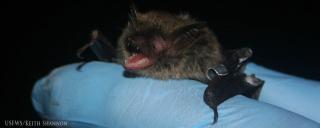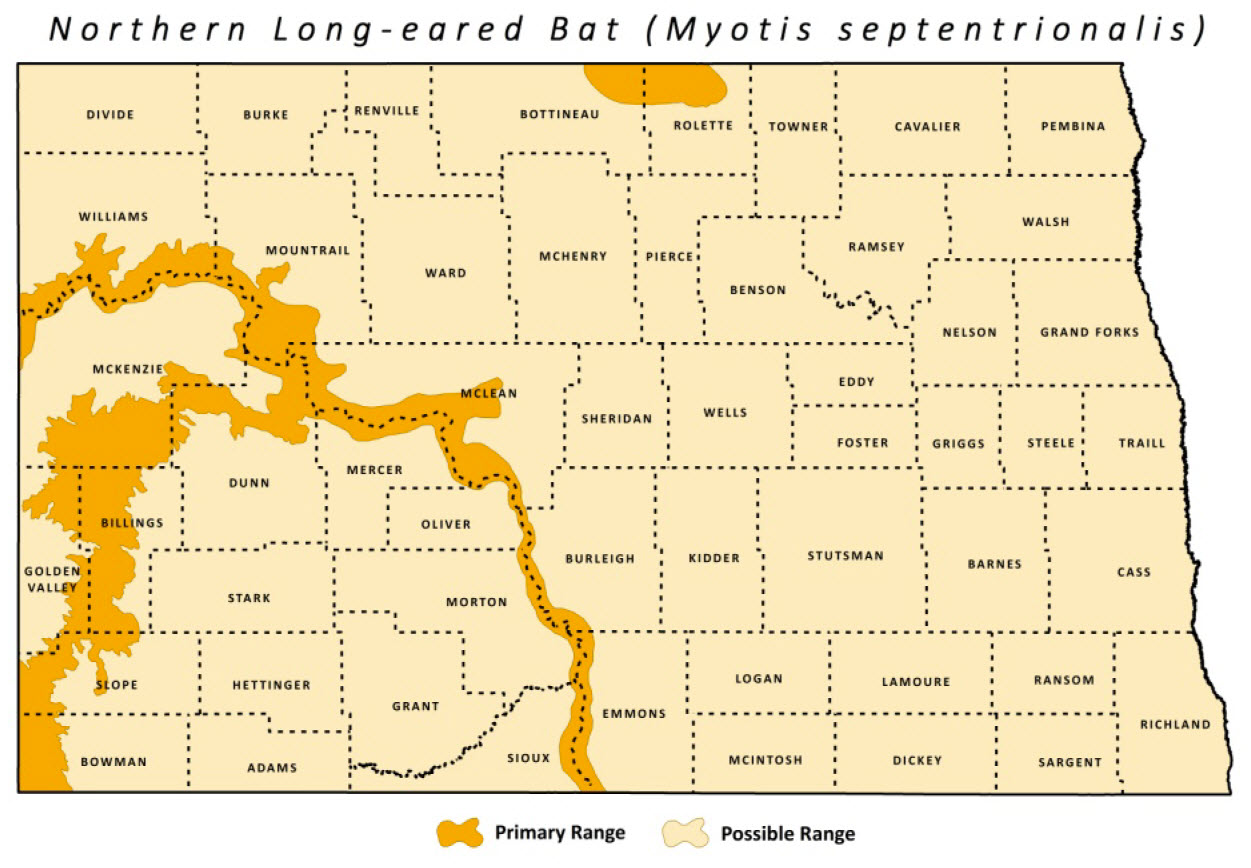
Northern Long-eared Bat
| Scientific Name | Myotis septentrionalis |
|---|---|
| General Description | Small bat. Fur generally brown in color. Ears and tail are longer than other myotis species of its size. Tragus also longer than similar sized bats, such as the Little Brown Bat. |
| Status | Seasonal as no hibernacula have been identified for this species in the state. |
| Abundance | Rare |
| Primary Habitat | Primarily found in woodlands within its range. |
| Federal Status | Endangered. |
| Reason for Designation | Rare to the state. Listed as Endangered under the Endangered Species Act. Listed as a state species of concern in Minnesota. A significant loss of individuals to White-nosed Syndrome in eastern and Midwestern United States has caused a population concern range wide. |
Locations and Conditions of Key Habitat
Preferred Habitat
Prefers wooded habitat. Generally roosts in trees under loose bark or within holes. Hibernates within caves and mine shafts.
Key Areas and Conditions for Northern Long-eared Bat in North Dakota
This species has only been identified in a few locations in North Dakota. It has been documented in forested habitat in the Turtle Mountains, and the riparian corridors of the Little Missouri and Missouri rivers.
Problems Which May Affect this Species
Habitat
This and other bat species in the state rely on caves and crevices for hibernacula and maternal grounds. These sites are susceptible to human and other types of disturbance. Frequent disturbance may cause females to drop young in the rearing process or abandon the area.
Other Natural or Manmade Factors
Northern Long-eared Bat and other bats in North Dakota are insectivores. Pesticides used in the vicinity of feeding grounds would affect bat populations by killing prey. Also, bats are known to store pesticides within fat reserves. Loss of water sources for drinking is also a potential threat. When natural water sources are dry, bats may resort to drinking from stock tanks. These can be potential bat traps. Wind turbines have been identified as a source of mortality to bats and several turbine “farms” are under construction in parts of North Dakota. Indiscriminate killing due to a negative public perception has been identified as a possible threat to this species.
Research and Survey Efforts
Current Research or Surveys
- Identification of hibernacula in western North Dakota as well as their susceptibility to White-nose Syndrome is being conducted by North Dakota State University.
- North Dakota State University is currently developing a North Dakota Bat Management Plan.
Previous Research or Surveys
- A survey of bat species in the state was conducted by North Dakota State University.
- A number of agencies have surveyed for small mammals in the southwestern part of the state including, REAP, Theodore Roosevelt National Park, the U.S. Forest Service, and U.S. Bureau of Land Management.
Additional Research or Surveys Needed
- Research to assess primary threats to this species.
- Life History requirements for this species specific to North Dakota should be investigated.
Management Recommendations
- Protection and restoration of riparian habitat.
- Manage riparian habitats to maintain snags, connecting corridors, and edges.
- Maintain and improve seeps, ponds, and other wet areas as water sources.
- Education on the benefits and misconceptions about bats.
- Determine and protect nursery and hibernation sites.
- Provide roosting sites in areas where natural sites have been destroyed or disturbed.
- Reduce use of pesticides near waterways where bats forage.
Monitoring Plans
A monitoring protocol will be addressed in the North Dakota Bat Management Plan currently under development.
2005-2015 Progress
The Northern Long-eared Bat was added to the Species of Conservation Priority list during the revision of the Wildlife Action Plan in 2015. Listed as Endandered by the USFWS in 2023. Rare to North Dakota, Whitenose Syndrome threatens this species in much of its eastern range.

For more information about the northern long-eared bat see the USFWS website.
Note: A listing of works consulted when compiling the information on this page may be found in the 2015 State Wildlife Action Plan.
